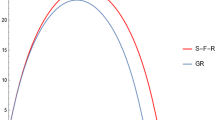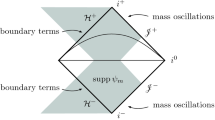Summary
An analysis is given of the fundamental question raised by Wheeler as to whether the Schwarzschild field, in the absence of a, finite interior solution, may be regarded as describing an everywhere empty space-time manifold. A model is constructed with a finite source tensor (the « island model »), and it is shown that one obtains a deltafunction point mass source tensor for the Schwarzschild field as a limiting case. It is also shown using Einstein’s pseudotensor that there is a contribution to the total energy of the Schwarzschild field that is not due to gravitational energy. In the course of the analysis, a subtraction formalism for handling gravitational energy divergences in polar co-ordinates is also developed. It is concluded that a source-free interpretation of the Schwarzschild field is not possible. A critique of the point mass is also given, and also an interpretation of the divergences as « gauge-jumps ».
Riassunto
Si analizza la questione della sorgente del campo di Schwarzschild in assenza d’una sorgente interna finita. Storicamente, questo campo è considerato come la soluzione delle equazioni di Einstein di una massa puntiforme, ma nell’interpretazione di Wheeler, c’è la soluzione dello spazio-tempo vuoto. Si esaminano le interpretazioni in contrasto dei due metodi. Primo, si costruisce un modello in oui si deriva la soluzione di Schwarzschild come limite di una soluzione con sorgente di massa distribuita. Secondo, si dimostra per mezzo del pseudotensore di Einstein che si trova un contributo all’energia totale non gravitazionale. Si fà questo calcolo nelle coordinate quasi rettangolari, e con un nuovo formalismo di sottrazione, nelle coordinate polari sferiche e nelle coordinate sotermiche non statiche. Si dimostra che è possibile eliminare in modo coerente le divergenze nelle coordinate polari. Si conclude che non è possibile considerare il campo di Schwarzschild come lo spazio-tempo vuoto. Si espone uno studio critico della massa puntiforme e anche un’interpretazione delle divergenze come « salti di gauge ».
Similar content being viewed by others
References
F. R. Tangherlini:Phys. Rev. Lett.,6, 147 (1961).
J. A. Wheeler:Geometrodynamics (New York, 1962);Rev. Mod. Phys.,3, 63 (1961).
F. R. Tangherlini:Nuovo Cimento,25, 1081 (1962).
L. Flamm:Phys. Zeits.,17, 448 (1916).
E. Schrödinger:Phys. Zeits.,19, 4 (1918); G. NordströmProc. Amst. Acad. Sci.,20, 1230 (1918). For comments see A. Einstein:Phys. Zeits.,19, 115 (1918); J. N. Goldberg:Phys. Rev.,111, 315 (1958).
F. B. Tangherlini:Nuovo Cimento,26, 497 (1962).
E. W. Fuller andJ. A. Wheeler:Phys. Rev.,128, 919 (1963).
H. Zatzkis:Phys. Rev.,35, 875 (1951).
P. von Freud:Ann. Math.,40, 417 (1939).
This is essentially Laue’s theorem, for recent applications and discussions seeC. MØller:Ann. Phys.,12, 118 (1961); F. R. Tangherlini:Am. Journ. Phys.,31, 285 (1963). For brevity we. have referred to the integral of the trace of the spatial stresses as the self-stress, since for a spherically symmetric system they are proportional, to each other.
A. Papapetrou:Proc. Roy. Irish, Acad.,51, 191 (1947);Phys. Rev.,73, 1105 (1948). In the latter reference, it is shown how the Serini, Einstein, Pauli theorem, follows as a simple consequence of the identity. The theorem states that there is no static, or stationary singularity-free solution to RΜv=0, which goes over asymptotically into the Schwarzschild solution. The original references are E. Serini:Atti Accad. Lincei (5),27, 235 (1918); A. Einstein: Revista (Univ. Nac. Tucuman), A2, 11 (1941); A. Einstein and W. Pauli:Ann. Math.,44, 131 (1943) ; A. Ltchnerowicz : Compt.Rend.,222, 432 (1946). See also W. Pauli:Theory of Relativity (London, 1958), note 18, p. 219.
E. T. Whittaker:Proc. Roy. Soc. (London),A 149, 384 (1935).
R. G. Tolman:Phys. Rev.,35, 875 (1930).
H. Bauer:Phys. Zeits.,19, 163 (1918).
C. MØller:Ann. Phys.,4, 347 (1958);Phys. Lett.,3, 329 (1963). J. Weber:General Relativity and Gravitational Waves (New York, 1961), p. 79. J. N. Goldberg:Phys. Rev.,131, 1367 (1963). Our present discussion is restricted to Schwarzschild-like solutions, but we shall treat other types of solutions in a sub- sequent article.
A. Einstein andN. Rosen:,Phys. Rev.,48, 73 (1935).
M. Kruskal:Phys. Rev.,119, 1743 (1960); see also C. Frondsal:Phys. Rev.,116, 778 (1959).
F. R. Tangherlini:Nuovo Cimento,27, 636 (1963).
P. A. M. Dirac:Proc. Roy. Soc. (London),270 A, 354 (1962).
The infinity of these subgroups of course underlies Bergmann’s theorem on the existence of an infinite number of conservation laws in general relativity, seeP. G. Bergmann:Phys. Rev.,112, 287 (1958); see also A. Teautman: op. cit., p. 175.
Author information
Authors and Affiliations
Rights and permissions
About this article
Cite this article
Tangherlini, F.R. Source of the Schwarzschild field. Nuovo Cim 38, 153–174 (1965). https://doi.org/10.1007/BF02750446
Received:
Revised:
Published:
Issue Date:
DOI: https://doi.org/10.1007/BF02750446




